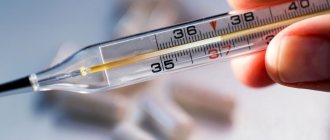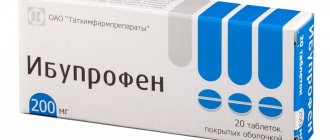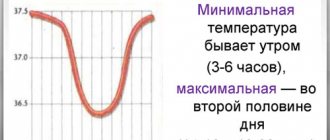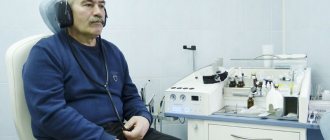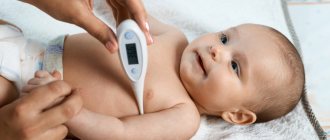An increase in body temperature is a symptom that expresses the body's response to an inflammatory process, the invasion of an infectious agent or toxin. You should take an antipyretic if the thermometer shows more than 38.5°C. For chronic diseases and poor health, intake is also indicated at a lower value.
Pharmacy chains offer a wide range of medications for fever. We will look at which of them are most effective for adults and children in the article.
How to lower an adult's fever: 8 best drugs
September 14, 2021
15193
4.7
1
Content
- How to choose fever pills
- Why does the temperature rise
- What to do at elevated temperatures
- How to reduce fever without medication
- The best antipyretics
- Paracetamol
- Nimesil
- Nurofen Long
- Theraflu ExtraTab
- Ibuklin
- Maxicold
- Rinza
- Aspirin
An increase in temperature is a signal from the body that there is an inflammatory process somewhere. An increase in temperature is a protective response of the immune system, the purpose of which is to eliminate the problem. But there are situations when the temperature urgently needs to be brought down. We will tell you which antipyretic pills are best to choose.
How to choose fever pills
Antipyretic drugs come in two categories:
- antipyretics
(such drugs have a good antipyretic effect, they relieve pain a little, but do not in any way affect the source of inflammation). These are mainly paracetamol-based drugs; - NSAIDs
(these drugs relieve inflammation, reduce pain and reduce fever). In this category, the most famous drug is aspirin, but it has a lot of side effects. Today, instead of aspirin, there are many other, safer drugs for fever. One of them is ibuprofen.
Review of antipyretic drugs for children with different active ingredients
The list of antipyretics for children includes various groups of drugs that block the production of substances that enhance the body's thermal response. The active ingredients approved for use in pediatric practice are paracetamol, nimesulide, and ibuprofen.
Paracetamol
+
Today, paracetamol is one of the most well-known antipyretic drugs used to relieve the unpleasant symptoms of a cold. Produced in a variety of dosage forms (effervescent and chewable tablets, capsules, syrups, rectal suppositories, powders and solutions for injections), in addition to its ability to lower temperature, it acts as a mild analgesic and anti-inflammatory. Unlike other antipyretics, paracetamol-based drugs do not affect normal body temperature. They are quickly absorbed into the blood, in therapeutic doses do not disrupt metabolic processes in the body, and practically do not give side effects from the gastrointestinal tract1,2,3,5.
–
Despite the fact that paracetamol-based antipyretic for children is considered one of the safest, in some cases its use can cause the development of allergic reactions. However, in the presence of severe inflammation, paracetamol, due to its weak anti-inflammatory effect, does not have the desired therapeutic effect. With caution - infants up to 3 months.
According to the recommendations of the World Health Organization (WHO), a single dose of paracetamol required to eliminate the symptoms of flu and colds should be up to 1000 mg for children and up to 2000 mg for adults1,3.
Nimesulide
+
Nimesulide, which belongs to the group of nonsteroidal anti-inflammatory drugs, has a high safety profile, does not irritate the mucous membrane of the digestive tract, has a pronounced analgesic, antiallergic4 and antibradycardinic (restores heart rhythm) effect, and is characterized by fairly high tolerability4.
–
Experts insist that using nimesulide as an analgesic and antipyretic is permissible only if paracetamol is ineffective, strictly as prescribed and under the supervision of a doctor. Also, when taking the drug, you need to take into account that standard doses of nimesulide in some cases can cause a sharp decrease in temperature (by 3 degrees within an hour). Therefore, it is better to start using it with half the dosage, and only then, if necessary and according to the doctor’s indications, increase it. The list of contraindications to nimesulide includes children under 12 years of age due to the aggressive effect of the drug on the liver.
Ibuprofen
+
Ibuprofen is a non-steroidal anti-inflammatory antipyretic for children, which also has an analgesic and pronounced anti-inflammatory effect. Preparations containing ibuprofen as an active component improve blood microcirculation, inhibit platelet aggregation, reduce fever and the intensity of inflammation1,2,3.
–
This anti-inflammatory and antipyretic for children is recommended to be used no more than once every 6-8 hours and only if paracetamol-containing drugs do not provide the required therapeutic effect. Ibuprofen is contraindicated in infants under 3 months. According to indications, it is possible to use a suspension from 3 months, drops from 2 years, coated tablets from 6 years, extended-release capsules from 12 years. Ibuprofen-based medications can cause side effects, which you should be aware of before starting use.
Up to contents
Why does the temperature rise
The temperature can rise for various reasons. All of them can be divided into the following groups:
- Infectious diseases caused by viruses (ARVI, influenza, intestinal infections, coronavirus, etc.).
- Infections caused by bacteria (tonsillitis, bronchitis, pharyngitis, pneumonia, skin inflammation and intestinal infections).
- Complications after operations, post-traumatic complications due to infection and tissue inflammation.
- Autoimmune diseases.
- Oncological processes (including blood diseases).
Also, body temperature may increase after overheating, against the background of endocrine diseases, due to problems with metabolism or taking certain medications. Non-pathological causes of fever also include: stress, premenstrual syndrome, menstruation, pregnancy, teething in babies.
By the way, a slightly elevated temperature can sometimes be a variant of the norm - as an individual feature of the body.
Dosage forms of antipyretic drugs for children
The modern pharmacological industry offers customers a large list of safe antipyretics for children (antipyretics). This list includes suppositories, suspensions, powders, syrups and tablets1,7. Moreover, each of the dosage forms has its own advantages and disadvantages.
Candles
+
Antipyretic drugs for children, produced in the form of rectal suppositories, can be used from the first months of a child’s life7. Their use at a very early age is more comfortable and less problematic than taking oral forms. Also, children's antipyretic suppositories are preferable if an increase in body temperature is accompanied by vomiting or there is a predisposition to the development of food allergic reactions1,2,3.
–
At the same time, antipyretic suppositories for children, in addition to their advantages, also have disadvantages. Potentially, they can provoke irritation of the mucous membrane of the anal canal. In addition, rectal suppositories in rare cases can cause the development of such negative side reactions as abdominal pain, nausea, and stool disorders.
Suspensions
+
Antipyretic drugs for children, available in the form of suspensions, make it possible to simultaneously use insoluble and soluble components1,2.
–
The main disadvantages of this pharmacological form: instability (sufficiently rapid sedimentation of suspended particles, which does not allow precise dosing of the medicine), the presence of flavorings that can cause allergies, and a short shelf life.
Powders
+
Children's antipyretics, produced in the form of powders for preparing a hot drink, can consist of one, two or more components and simultaneously provide antipyretic, analgesic and anti-inflammatory effects. This dosage form, manufactured on equipment designed for the finest grinding, has a larger area of contact with body tissues and, as a result, has a more pronounced pharmacological effect. Children's antipyretic in powder form is easy to dose, it is relatively easy to prepare and is easy to transport.
–
In some cases, the powder product may acquire foreign odors, become damp when exposed to moisture, and deteriorate when exposed to light.
Syrups
+
Antipyretic syrups for children are water-based medications. They contain an active antipyretic component, sucrose and excipients. They have a fairly pleasant taste, are easy to dose and, due to their dissolved state, begin to act almost immediately1,2.
–
Children take antipyretic drugs in the form of syrups with much greater pleasure than tablets. However, due to the high content of sugar and flavorings, these products can provoke the development of an allergic reaction, and the thickness and cloying sweetness can cause nausea and vomiting in a child.
Pills
+ Antipyretic tablets for children are a dosage form for oral administration, obtained by pressing or molding from a mixture of active and auxiliary substances. As a rule, they contain the same active ingredients as antipyretic drugs for adults, only in a lower dosage. The advantages of tablet forms include dosing accuracy, portability, ease of transportation, long shelf life, and prolonged action2.
–
Antipyretics for children in the form of tablets are not suitable for all ages, which should be taken into account when choosing a drug. In addition, many children refuse to “drink bad-tasting medicine”; some develop a gag reflex, and if there is severe vomiting, taking pills is impossible.
Based on all of the above, the conclusion suggests itself: the question of which antipyretic is best for a child cannot be answered unequivocally. Any dosage form intended to stabilize temperature indicators must be used taking into account the age restrictions specified in the instructions and in strictly recommended doses. A preliminary consultation with a doctor is required.
Up to contents
What to do at elevated temperatures
If you have a slight fever, do not rush to immediately swallow an antipyretic. If the numbers are 38-38.5, just try to have a good rest, drink a lot of warm liquids and get some sleep. Give the body the opportunity to cope with the infection on its own.
If you feel normal at an elevated temperature (up to 38.5 degrees), you are at home, you can try to lower the temperature without pills: wipe your body with a damp towel moistened with water at room temperature.
But if you do not tolerate an increase in temperature, it has risen above 38.5 degrees, be sure to take an antipyretic. Especially if you have a headache, general weakness or convulsions (in this case you need to call an ambulance).
Take any medications (including antipyretics) with caution if you are prone to allergies. Often tablets or syrups for fever contain flavorings and dyes.
Often the dose of fever medication is calculated based on body weight. If a child’s temperature has risen, it can only be brought down with certain medications, so be sure to check the instructions for contraindications.
Tablets for fever, as we wrote above, are divided into two groups: NSAIDs and antipyretics. Drugs based on NSAIDs in combination with antispasmodics are good at reducing fever, which does not decrease for a long time (usually emergency doctors give such injections). But before using drugs with NSAIDs, it is necessary to assess the general health of the patient - NSAIDs are contraindicated for gastrointestinal diseases.
At elevated temperatures, it is imperative to look for the cause and fight it. This is usually a viral or bacterial infection. If it is bacterial, antibiotics are prescribed, but if it is a virus, then there is no special treatment, only symptomatic. Antiviral drugs are ineffective here. It is important to immediately consult a doctor if antipyretic drugs do not reduce the temperature well or the condition only worsens.
The best antipyretic syrups for children
Children, especially newborns, should be given only special syrups, since tablets, suppositories, etc. are not suitable. From the entire range, we were able to identify 2 of the best antipyretics for children in the form of tasty liquids, which are effective and safe.
Nimulid
The drug "Nimulid" reduces inflammation, relieves pain and reduces fever. It is strong enough and can be used for chickenpox and other colds. After consuming this antipyretic, the child begins to sweat within 1-2 hours, and the effect lasts up to 8 hours. Despite the permission for use by children, it is better to give the syrup after consulting a doctor. The dosage of the suspension depends on the child’s weight and is prescribed at the rate of 1.5 mg per 1 kg of weight. The recommended frequency of use of the composition is 2-3 times a day. To avoid overdose, you can take no more than 5 mg/kg per day.
Advantages
- Fast and long-lasting effect;
- Affordable price - up to 150 rubles;
- Pleasant taste;
- Removes muscle pain;
- Copes even with persistent and very high temperatures.
Flaws
- Large list of contraindications and side effects.
Nimulid is a strong drug that somewhat overloads the liver; it is appropriate to use it only when the temperature is too high, in other cases it is better to resort to a more gentle remedy.
Panadol
This is a universal drug for reducing headaches, alleviating teething and eliminating fever. It has a pronounced antipyretic and analgesic effect. The medicine is based on paracetamol, a safe substance, although not as strong as nimesulide. Panadol begins to act within 40 minutes after administration, maintaining normal temperature for at least 4 hours. It can be prescribed to children from 3 months of age and for infectious diseases: measles, mumps, colds, flu.
This is a good, time-tested medicine for fever, which removes not only fever, but also pain. The syrup can be used from an early age in adequate dosage and rarely causes side effects. Due to its gentle effect on the child’s body, I recommend it to everyone, with the exception of children with severe fever and pain.
Advantages
- Gentle on the stomach;
- Analgesic effect;
- Pleasant aroma and taste;
- Minimum of adverse reactions;
- Costs less than 100 rubles.
Flaws
- The composition contains dyes;
- Short-term effect.
Panadol is best used for children whose temperature does not exceed 38.5°C. If the readings on the thermometer are high, this antipyretic cannot cope; a stronger analogue is needed.
How to reduce fever without medication
There are non-drug methods of reducing fever that can be used either alone or while taking antipyretics.
- If you are feeling chilly, you should not wrap yourself up too much, so as not to disrupt heat transfer - this will only aggravate the condition. You need to cover yourself until you are comfortable, but not too hot.
- Don't forget to have enough liquid. The body tries to cool down - the body sweats and loses fluid. If there is little water in the body, the condition will worsen. The liquid also helps remove waste products of pathogenic microorganisms from the body.
- If you don't have an appetite, don't force yourself (or your child) to eat. During illness, all the body's strength is spent fighting infection.
- To reduce your temperature without medication, wipe your body with a towel moistened with water at room temperature.
- At elevated temperatures, ice can be applied to large vessels. First you need to crush the ice and put it in a bag. An ice pack should be applied through a towel - to the groin folds, armpits, forehead, popliteal fossa.
- Raspberry, cherry, currant, and strawberry jam are considered folk remedies for fever (you can add tea or simply stir with warm water).
If the above methods of reducing fever do not work, be sure to take an antipyretic.
The best antipyretic suppositories
Remedies in the form of suppositories have a strong overall effect on the body. The effectiveness of suppositories depends on the amount of substances in their composition that can penetrate into the general bloodstream. 2 names of suppositories have a strong influence.
Cefekon N
This is the best remedy for fever that quickly removes chills and fever. It is based on salicylamide and naproxen, which stimulate sweating, thereby reducing high fever. Suppositories have not only an antipyretic effect, but also analgesic and anti-inflammatory effects. They contain caffeine, a psychostimulant and tonic substance that improves a person’s overall well-being without injections or other medical procedures.
Advantages
- Long-lasting effect that lasts about 8 hours;
- Do not have a negative effect on the gastrointestinal tract;
- Affordable price - 140 rubles. for 10 suppositories;
- Suppositories do not cause discomfort when administered;
- Fast action, noticeable after 15-20 minutes.
Flaws
- There are many contraindications and side effects.
After inserting the suppository, you need to remain in a horizontal position for 40 minutes, which makes it inconvenient to use Cefekon N during work.
Voltaren
These are non-steroidal anti-inflammatory suppositories with an active component in the form of diclofenac sodium, which has a rapid effect. They not only suppress pain, but also have a strong anti-inflammatory effect. Within 5-10 minutes after using the suppositories, their components are completely absorbed and begin to work. Doctors recommend using them not only as an antipyretic, but also for severe pain (migraine, neuralgia, etc.). Voltaren has a large number of contraindications, so it is better to treat it with pronounced discomfort and high temperature.
Advantages
- Strong analgesic effect;
- Effective 10 minutes after administration;
- Has an anti-inflammatory effect;
- Prescribed for rheumatic diseases;
- Widespread in pharmacies.
Flaws
- Serious side effects;
- High price - about 250-300 rubles. for 5 candles.
Due to the presence of some adverse reactions, Voltaren is best used only at temperatures above 38°C or in case of severe pain. It is always important to adhere to the recommended course of administration, otherwise there is a risk of overdose.
Paracetamol
You can buy Paracetamol in tablets, capsules, syrup, suspension and in the form of rectal suppositories. The active substance is paracetamol. The antipyretic is available without a prescription. This is the safest remedy, effective and prescribed for ARVI. Compared to other drugs, Paracetamol is weaker because it does not have an anti-inflammatory effect - for bacterial infections it is better to choose other tablets for fever. Paracetamol moderately reduces headaches and reduces general malaise. The temperature begins to drop 30-40 minutes after taking the drug, the effect lasts for 4-6 hours. Paracetamol is safe for both children and the elderly, pregnant and lactating women. The only exception is people with severe liver disease and chronic alcoholism. Paracetamol should not be taken with alcohol, for prophylaxis or as a course - only at high temperatures.
Paracetamol MS
Medisorb, Russia
Paracetamol is used for: relieving moderate or mild pain (headache, toothache, migraine, sore throat, neuralgia, myalgia);
reducing elevated body temperature during colds and other infectious and inflammatory diseases. Paracetamol is intended for symptomatic therapy, reducing pain and inflammation at the time of use, does not affect the progression of the disease. from 2
5.0 1 review
221
- Like
- Write a review
Which antipyretic brand is better to choose?
Leading positions in the list of the best companies are occupied by Indian, Russian and European pharmaceutical manufacturers. They offer the most advanced developments to combat elevated body temperature, the effectiveness of which has been confirmed by numerous studies.
We present the TOP 9 companies producing antipyretics:
- Reddy's (Ibuklin) is an Indian pharmaceutical company headquartered in Hyderabad, founded by Anji Reddy in 1984. It ranks second within the country in terms of the number of funds issued. The company produces both analogues of well-known drugs and patented drugs, for example, Ibuklin, Dexpan Plus, etc. The manufacturer’s tablets are highly effective, but they are also more expensive than their analogues.
- Sopharma (Analgin-quinine) is a large Bulgarian drug manufacturer, which is famous for its good quality products and loyal pricing policy, which has led to the distribution of its drugs in pharmacies throughout Russia. The company's antipyretic medications are indicated not only for high body temperature, but also for painful sensations.
- Pharmstandard (Paracetamol) is a domestic company headquartered in business. It is the largest and most influential pharmaceutical company in the domestic market. The company produces Paracetamol, a cheap drug for relieving fever, pain and inflammation.
- Menarini Group (Nimesil) is an Italian pharmaceutical company established in 1886. The company’s priority is the fight against oncology, pain, inflammation, and asthma. She released one of the most effective and popular powders against fever - Nimesil with a pleasant taste.
- Famar Orlean (TeraFlu) is a European company with Swiss roots, developing drugs to combat influenza. Its most famous product is TheraFlu. This medicine successfully fights cold symptoms: runny nose, cough and high fever, a noticeable effect is observed after 1 hour.
- GlaxoSmithKline (Coldrex, Panadol) is the world's second largest drug distribution company. One of the key areas is the sale of drugs for the treatment of respiratory diseases. Coldrex relieves nasal congestion, relieves pain, lowers body temperature and enriches the body with vitamin C; Panadol is an inexpensive product that relieves pain and fights fever in children.
- Nizhpharm (Tsefekon N) is a Russian company that has been part of the Stada group since 2004; the plant appeared in 1919 in Nizhny Novgorod. The company produces a third of all drugs that are exported. All its products are of high quality and comply with European standards.
- Novartis (Voltaren) is a transnational company (the second in Europe), which is largely engaged in the production of drugs for the treatment of oncology. Among its products is Voltaren, which has an anti-inflammatory effect. It is also effective in relieving fever and other cold symptoms.
- Panacea Biotec (Nimulid) is a progressive pharmaceutical company aimed at developing new drugs. Its two main areas of activity are the production of drugs for pain and for the treatment of diabetes. One of the modern medicines is Nimulid, which has antipyretic, analgesic and anti-inflammatory effects.
The best cough syrups for children
Nimesil
The active ingredient of the antipyretic drug is nimesulide. These are NSAIDs with pronounced anti-inflammatory, antipyretic and analgesic effects. You can buy Nimesil at the pharmacy in individual sachets. Among the contraindications to taking Nimesil are diseases of the gastrointestinal tract (the full list is listed in the instructions, so be sure to read it before taking the drug). "Nimesil" should be used only after consultation with a doctor.
Nimesil
Berlin-Chemie/Menarini, Germany
Treatment of acute pain (back pain, lower back pain; pain syndrome in the musculoskeletal system, including injuries, sprains and dislocations of joints, tendonitis, bursitis; toothache);
— symptomatic treatment of osteoarthritis with pain syndrome; - algodismenorrhea. The drug is intended for symptomatic therapy, reducing pain and inflammation at the time of use. from 24
5.0 2 reviews
1667
- Like
- Write a review
Which antipyretic is better to buy?
To normalize the temperature on the road or at work, it is better to use tablets. Powders are worth recommending as easy-to-take and tasty preparations. To quickly eliminate most cold symptoms, candles are suitable. Doctors advise children to give medications only in the form of syrups.
Here are some recommendations for choosing antipyretics:
- If you need a universal remedy for various symptoms of flu and colds, then it is better to purchase Ibuklin.
- As a universal symptomatic remedy for eliminating pain and high fever at an affordable price, it is worth buying Analgin-Quinine.
- When looking for inexpensive tablets to reduce fever and reduce pain in the head, Paracetamol is the best choice.
- To quickly reduce fever of any origin and reduce the severity of toothaches, it is recommended to use Nimesil.
- If you need to quickly relieve cold symptoms, it is appropriate to use TheraFlu.
- If you need to choose a universal remedy for the comprehensive relief of nasal congestion, sore throat and fever, Coldrex will be a good drug for your home first aid kit.
- Those who need to return to normal well-being and normalize their temperature in 1 hour are recommended to purchase Cefekon N. Results can be obtained within half an hour, and after another 30 minutes the person feels relief.
- Those wishing to purchase a drug with the fastest antipyretic effect should buy Voltaren, which is also good at relieving severe pain.
- If the child's temperature is too high, it is better to use Nimulid.
- For those who want to buy a simple, cheap and safe syrup to eliminate fever in children, it is better to take Panadol.
The formed rating of the best antipyretic drugs for children and adults included the most effective, safe and at the same time inexpensive drugs and products. However, if used incorrectly, they can have certain consequences. If such undesirable manifestations appear after taking it, you should make an appointment with a doctor and stop using the medication.
Nurofen Long
"Nurofen Long" for fever is sold in tablets, capsules, syrup. You can also buy a combination drug "Nurofen" with paracetamol. Nurofen does not require a prescription, and its active substance is ibuprofen (NSAID). Nurofen Long perfectly reduces the temperature literally 20 minutes after taking the tablet, and the effect lasts for 8 hours. The drug also reduces muscle pain, relieves headaches and inflammation, relieves nasal congestion, and relieves pain. Nurofen Long is recommended for bacterial infections and exacerbation of chronic diseases. The drug helps with elevated temperature due to ARVI. Contraindications include intolerance to ibuprofen and fructose, gastrointestinal diseases (including gastritis and ulcers), liver and kidney diseases. You should not drink alcohol while taking Nurofen. Nurofen is prescribed during pregnancy only if there is an urgent need.
Nurofen Long
Reckitt Benckiser, Netherlands
Backache;
joint pain; muscle and rheumatic pain; neuralgia; headache; migraine; toothache; painful menstruation; a sore throat; feverish condition; cold and flu symptoms. The drug is especially indicated for the symptomatic treatment of pain requiring a more pronounced analgesic effect than ibuprofen or paracetamol alone. from 137
544
- Like
- Write a review
Causes of high temperature
Any inflammatory process can cause an increase in temperature. The nature of inflammation can be different - bacterial, viral, fungal. In most cases, the temperature is a concomitant symptom: for example, with otitis media, the ear hurts (“twitches”) and the temperature is elevated...
Temperature attracts special attention when no other symptoms are observed. Temperature against the background of standard signs of ARVI is ordinary, but only one high temperature is frightening.
Diseases that may cause a high fever without other symptoms
:
- ARVI and influenza. Flu, and in some cases other acute respiratory viral infections, can begin with a sudden rise in temperature. In this case, catarrhal symptoms begin somewhat later (in the late afternoon or the next day);
- angina. Along with fever, there is usually a sore throat when swallowing. The pain in the throat intensifies quite quickly, so that it cannot be ignored;
- chickenpox (chickenpox). The typical onset of chickenpox is high fever. Characteristic rashes may appear only on the 2-3rd day of illness;
- abscess (accumulation of pus in superficial tissues or internal organs). With an abscess, the temperature “floats”: temperature peaks can be interspersed with normal temperature during the day (in contrast to the typical temperature schedule for an “ordinary” infectious disease - when the lowest temperature is observed after waking up in the morning, and rises in the evening);
- inflammations of the genitourinary system (pyelonephritis, glomerulonephritis) are usually manifested by high fever and pain in the projection of the kidneys. But in some cases there may be no pain;
- appendicitis - can also occur without pain;
- meningitis and encephalitis (inflammation of the meninges of infectious origin). In this case, high temperature is accompanied by severe headache, nausea, and blurred vision. A characteristic symptom is tension in the neck muscles (the chin cannot be lowered to the chest);
- hemorrhagic fever (usually infection occurs through the bite of wild animals, for example, a field mouse). This also has its own characteristic symptoms - a decrease (even cessation) of urination, the appearance of subcutaneous hemorrhages (spotted redness of the skin, rash), muscle pain.
Elevated temperature (up to 37.5-38°C) without pronounced other symptoms
may be observed with:
- tuberculosis;
- oncological diseases;
- diseases of the thyroid gland (thyrotoxicosis);
- neurological disorders;
- allergic reaction (this is how individual intolerance to medications may manifest itself).
The following diseases also occur with an increase in temperature:
- inflammation of the lungs (pneumonia). Pneumonia is a common cause of high fever. In this case, chest pain, shortness of breath, and cough are usually observed;
- infectious diseases of the gastrointestinal tract (gastroenterocolitis). Here temperature is a side symptom. Main complaints: abdominal pain, diarrhea, nausea, vomiting;
- viral hepatitis A, which is characterized by the appearance of a jaundiced coloration of the skin and whites of the eyes;
- other viral diseases - measles, rubella, mumps (mumps), mononucleosis, polio, etc.;
- chronic diseases of the urinary system (chronic pyelonephritis, cystitis), in women - chronic salpingoopharitis. Along with low-grade fever, abdominal pain and urination problems may occur;
- sexually transmitted diseases (gonorrhea, syphilis, urogenital infections - toxoplasmosis, trichomoniasis, ureaplasmosis, etc.);
- chronic myocarditis and endocarditis. In this case, the usual symptom is pain in the heart area;
- autoimmune diseases (rheumatism, systemic lupus erythematosus, etc.).
This, of course, is not a complete list of diseases that can cause fever
Theraflu ExtraTab
These fever tablets contain paracetamol, which reduces fever well. In addition, Theraflu ExtraTab contains phenylephrine (a vasoconstrictor) and chlorphenamine (an antihistamine). Therefore, the drug has a complex effect - it relieves swelling during a runny nose and reduces fever. Contraindications to taking Theraflu ExtraTab include stomach ulcers.
Theraflu extratab
Novartis Pharma Services AG (Novartis Pharma), Switzerland
Symptomatic treatment of infectious and inflammatory diseases (ARVI, including influenza), accompanied by high fever, chills, headache, runny nose, nasal congestion, sneezing, muscle pain.
from 148
346
- Like
- Write a review
Rules for taking antipyretics
- Without exception, all types of antipyretics for children are drugs with symptomatic action1. They do not cure colds and flu, but only reduce fever. Therefore, the efforts of parents should be aimed primarily at eliminating the causes that provoked the development of the disease.
- It is strictly not recommended to give antipyretics to the patient on a routine basis (several times a day, by the hour)1. They should be used only when necessary: if the child has a high fever or does not tolerate high temperatures.
- The duration of use of antipyretic drugs for children without consultation with the attending physician should not exceed 3 days. If during this time the child’s condition does not improve, it is necessary to urgently seek help from a specialist. A fever that does not go away for a long time may indicate a secondary bacterial infection that requires specific treatment.
Up to contents
Ibuklin
This is a complex antipyretic drug - here paracetamol and ibuprofen (antipyretic and NSAID). You can buy Ibuklin without a prescription; the product reduces fever well, relieves cold symptoms, reduces inflammation and body aches, and improves overall well-being. “Ibuklin” begins to act 20 minutes after administration, and the effect lasts 6-8 hours. Contraindications: liver and kidney diseases, gastrointestinal problems (ulcers, gastritis). Ibuklin should not be taken with alcohol.
Ibuklin
Dr. Reddy's Laboratories, India
- symptomatic treatment of infectious and inflammatory diseases (colds, flu), accompanied by fever, chills, headache, muscle and joint pain, sore throat;
- myalgia; - neuralgia; - back pain; — joint pain, pain syndrome in inflammatory and degenerative diseases of the musculoskeletal system; - pain from bruises, sprains, dislocations, fractures; — post-traumatic and postoperative pain syndrome; - toothache; - algodismenorrhea. The drug is intended for symptomatic therapy, reducing pain and inflammation at the time of use, and does not affect the progression of the disease. from 78
749
- Like
- Write a review
The best antipyretic powders and granules
Such drugs are usually diluted in water and consumed as a pleasant-tasting drink. Due to the active substances dissolved in it, the body absorbs them faster - the medicines begin to act within 20-30 minutes. On the modern market there are 3 best, according to our estimates, remedies in the form of powders for temperature.
Nimesil
The basis of the composition here is nimesulide, which blocks the inflammatory process and relieves mild to moderate pain. This product also has an antipyretic effect, which develops as pathological changes in the body subside. Doctors prescribe it for toothaches, colds, severe discomfort before and during menstruation. Sold in packs of 9 sachets (pharmacies often sell them one at a time). The frequency of use depends on how you feel, but the recommended dose is no more than 2 times a day. The maximum duration of treatment is 15 days.
Advantages
- Soft action;
- Minimal risk of developing undesirable effects;
- Quick effect - after 30-60 minutes;
- Long-term effects on the body (up to a day);
- It almost always has a positive effect.
Flaws
- Safety of use in children under 12 years of age has not been confirmed.
The contents of the sachet should be dissolved in 100 g of heated water and drunk. Nimesil works best when taken after meals. When dissolved, the product has a sweet-sour citrus flavor.
TeraFlu
The powder has a pleasant lemon taste and quickly fights the symptoms of flu and colds. The purpose of the drug is the symptomatic treatment of infectious and inflammatory diseases that are accompanied by chills, fever, pain and runny nose. TheraFlu constricts blood vessels, removes swelling of the nasal mucosa and nasopharynx. It also acts as an analgesic and antipyretic, these effects are achieved by suppressing the production of prostaglandins.
Advantages
- Removes the feeling of weakness and body aches;
- Pleasant lemon taste;
- Helps relieve nasal congestion;
- Reduces temperature;
- Convenient to use.
Flaws
- It is not recommended to use before work requiring special attention;
- There are some side effects.
Theraflu is the best antipyretic drug that helps the body cope with symptoms, but it is not a drug to fight viruses. The drug is not suitable for quick recovery.
Coldrex
This is a complex antipyretic drug for adults, consisting of 5 active substances. Paracetamol suppresses the symptoms of fever, relieves pain and removes the feeling of heat. Phenylephrine fights nasal congestion and makes breathing easier, caffeine tones the entire body, and ascorbic acid saturates it with vitamin C, which is needed to successfully fight colds. The powder can be taken by children over 6 years old; it is recommended for use in the first hours after the onset of symptoms.
Advantages
- The effect occurs within 30-40 minutes;
- Does not affect performance;
- Completely eliminates symptoms when consumed in a timely manner;
- Can replace several symptomatic medications at once;
- Pleasant aroma and taste.
Flaws
- It is advisable to refrain from excessive consumption of coffee, tea and alcoholic beverages.
The drug is well tolerated by the body, it can be used even during pregnancy and lactation, and it is also allowed to be given to children from 6 years of age. In special cases, it is not recommended to start taking it without consulting a doctor.
Maxicold
The drug "Maxicold" contains paracetamol. This antipyretic drug perfectly relieves all symptoms of ARVI. In addition to Maxicold, you can buy Maxicold Rhino at the pharmacy, which will effectively relieve a runny nose and swelling of the nasal mucosa thanks to phenylephrine and pheniramine (vasoconstrictor and antiallergic effects). Maxicold contains vitamin C, a natural antioxidant that strengthens the immune system and helps the body fight colds.
Maxicold
JSC Pharmstandard-UfaVITA, Russia
- symptomatic treatment of infectious and inflammatory diseases (including influenza and other acute respiratory viral infections (ARVI)), accompanied by fever, chills, nasal congestion, headache, pain in the bones and muscles, in the throat and sinuses.
from 39
379
- Like
- Write a review
Maxicold Rhino
OJSC Pharmstandard-Leksredstva, Russia
- symptomatic treatment of colds, acute respiratory viral infections, flu, accompanied by high fever, chills, headache, runny nose, pain in the sinuses and throat, nasal congestion, sneezing and pain in muscles and joints.
from 53
401
- Like
- Write a review
Choosing the optimal antipyretic drug in pediatric practice
Fever is one of the main reasons for seeking medical care in pediatrics, accounting for up to 30% of all doctor visits by children in general and up to 2/3 of visits by children under three years of age [1, 2].
Depending on the etiological factor, it is customary to distinguish two main groups of fever: infectious and non-infectious (with aseptic immune inflammation, tissue damage and dysfunction of the autonomic and central nervous system (CNS)) [3].
In Russia, fever in children is most often associated with infectious diseases, especially acute respiratory viral infections (ARVI). Most children with ARVI are treated at home; parents often resort to self-medication using over-the-counter analgesics [4].
Meanwhile, moderate fever is an important protective and adaptive reaction of the body, promoting the death of pathogens of infectious diseases, the production of antibodies, and the activation of phagocytosis and immunity. The use of antipyretics is sometimes undesirable due to the fact that they can mask the clinical manifestations of severe infections, delay the establishment of the correct diagnosis, which increases the risk of complications and deaths [5]. When a child receives antibacterial therapy, regular use of antipyretic medications may mask the insufficient effectiveness of the antibiotic [3].
On the other hand, an increase in body temperature to very high values (> 40 °C) can contribute to the development of cerebral edema and dysfunction of vital organs [6]. A rise in temperature above 38 °C is dangerous for children in the first two months of life due to imperfect thermoregulation processes, for children aged 6 months to 3 years who are at risk for the development of febrile seizures, as well as in the presence of severe respiratory and cardiovascular diseases. vascular systems, the course of which can worsen with fever [7].
In children with central nervous system pathology (perinatal encephalopathy, epilepsy, etc.), seizures may develop against the background of elevated body temperature [8]. Febrile seizures occur in 2–4% of children, most often at the age of 12–18 months [6].
The purpose of prescribing antipyretic drugs to children is not only to prevent the above complications and dehydration, but also to reduce the discomfort associated with fever [9, 10]. Moreover, some experts consider the elimination of discomfort to be the main goal of treating fever in pediatrics [11].
The question of using an antipyretic for fever in a child should be decided individually. Children at risk for developing complications from febrile reactions include:
- under 2 months of age with a temperature above 38 °C;
- with a history of febrile seizures;
- with diseases of the central nervous system;
- with chronic pathology of the circulatory system;
- with hereditary metabolic diseases [12].
Russian pediatricians recommend prescribing antipyretic drugs to children in the first 3 months of life at a temperature > 38 °C, and to children over 3 months (previously healthy) at a temperature > 39 °C and/or for muscle aches and headaches [13].
In addition, antipyretics are recommended for all children with a history of febrile seizures at temperatures > 38–38.5°C, and for severe heart and lung disease at temperatures > 38.5°C.
Antipyretic therapy should be carried out against the background of etiological treatment of the underlying disease, and in children with allergic diseases (atopic dermatitis, allergic rhinitis) against the background of the use of antihistamines [4].
When choosing an antipyretic drug, it is always necessary to weigh its benefit/risk ratio for a given pathology, assessed on the basis of the results of adequate randomized controlled trials. It is necessary to give preference to the most well-studied drugs in pediatrics, of which there are very few today - 75% of drugs on the pharmaceutical market have never been studied in adequate clinical studies in children [14, 15]. An important factor when choosing a drug for children is also the availability of pediatric dosage forms and their organoleptic properties (taste, smell), as well as ease of dosing and use, which allows increasing adherence to pharmacotherapy and preventing medical errors.
Among the drugs with analgesic and antipyretic effects, the most well studied in pediatrics are ibuprofen and paracetamol. These drugs are recommended by the World Health Organization; they are the only representatives of their group approved for over-the-counter use for fever and pain in children in most economically developed countries, including the Russian Federation. Paracetamol and ibuprofen can be prescribed to children from the first months of life both in a hospital and at home [3]. The use of other non-opioid analgesics and non-steroidal anti-inflammatory drugs (NSAIDs) in pediatric patients is limited due to both the lack of data on effectiveness in this population and the risk of serious side effects. Some NSAIDs are only available by prescription for the treatment of arthritis in children and adolescents.
It should be noted that there are significant differences between paracetamol and ibuprofen that must be taken into account when choosing antipyretics (Table).
Ibuprofen, unlike paracetamol, has not only antipyretic and analgesic, but also anti-inflammatory properties, so its use is more preferable in children with fever accompanied by inflammatory processes, for example, sore throat, otitis media, arthritis, etc. [16]. Table. Regimens for the use of paracetamol and ibuprofen for the treatment of fever in children [8]
| Medicine | Mode of application |
| Paracetamol | 15 mg/kg no more than 4 times a day with an interval of at least 4 hours |
| Ibuprofen (Nurofen for children) | 5–10 mg/kg 3–4 times a day |
Evidence of the effectiveness of ibuprofen for fever in children
The effectiveness and safety of ibuprofen in children with fever has been studied in more than 120 clinical trials, most of which included paracetamol as a comparator [17].
The results of these studies indicate that, both in single doses and in repeated doses, ibuprofen is at least as effective as or superior to paracetamol.
For example, in an open-label, randomized, three-parallel group study of children aged 6–24 months, ibuprofen at a dose of 7.5 mg/kg was superior to paracetamol and acetylsalicylic acid (both at a dose of 10 mg/kg) [18]. ].
A more pronounced antipyretic effect of ibuprofen at doses of 7.5 and 10 mg/kg compared with paracetamol at a dose of 10 mg/kg has been demonstrated in a number of other clinical studies in children [19–23]. Additionally, in a double-blind, placebo-controlled, randomized clinical trial of 127 children 2–11 years of age, ibuprofen was shown to be better at reducing high fever (>39.2°C) than paracetamol [24].
The higher efficacy of ibuprofen as an antipyretic in children when used at a dose of 5–10 mg/kg compared with paracetamol at doses of 10–12.5 mg/kg was confirmed by the results of a meta-analysis that included 17 blinded randomized clinical trials [17]. The superiority of ibuprofen was observed at all time intervals studied (2, 4 and 6 hours after administration) and was most pronounced between 4 and 6 hours after the start of treatment, when the effect of ibuprofen was more than 30 points higher than the effect of the comparison drug. When studies in which ibuprofen was used at a dose of 5 mg/kg were excluded from the analysis, its advantage over paracetamol increased even more (the effect was approximately 2 times stronger than that of paracetamol). The incidence of side effects, including gastrointestinal and renal side effects, was similar.
The conclusion about the superiority of ibuprofen over paracetamol in terms of antipyretic and analgesic efficacy in adults and children was also made in the latest published meta-analysis, which included data from 85 comparative clinical studies of these drugs, including 35 studies comparing antipyretic activity [26].
Analysis of published data allows us to recommend ibuprofen as the drug of choice for the treatment of fever in children, since it causes a more pronounced decrease in body temperature than paracetamol, without increasing the risk of adverse events [27].
Very interesting data were obtained in a study by Autret-Leca et al. (2007): Although ibuprofen and paracetamol were found to be comparable in effectiveness and tolerability, significantly more parents in the ibuprofen group than in the paracetamol group rated the drug their children were receiving as “very effective” both open-label and in the blinded phase of the study [28]. The authors believe that this assessment may be explained by some additional benefit of the drug, which could not be measured in this study, but reduced parents' anxiety about their children's treatment.
Another study focused on parental satisfaction when their children (n = 490) received ibuprofen suppositories as an antipyretic at a dose of 5–10 mg/kg/dose [29]. The average rating of parents' satisfaction on a 5-point scale was 4.5 ± 0.47; 92.2% of parents said they would use this drug in the future.
There are fewer comparative studies of ibuprofen with other antipyretics, since the use of the latter (for example, acetylsalicylic acid and metamizole sodium) in children is limited due to safety concerns. However, available evidence suggests that ibuprofen is also superior in effectiveness. As mentioned above, ibuprofen at a dose of 7.5 mg/kg was superior in effectiveness to acetylsalicylic acid at a dose of 10 mg/kg [18].
In a comparative study of 80 children aged 6 months to 8 years, a single dose of ibuprofen 10 mg/kg had a greater antipyretic effect than a single dose of Dipirone (metamizole sodium) 15 mg/kg [30]. The benefit of ibuprofen was particularly pronounced in children with high (>39.1°C) body temperature. In other comparative clinical studies, ibuprofen was not inferior in effectiveness to metamizole sodium preparations for intramuscular administration, which allowed the authors to recommend giving preference in pediatrics to ibuprofen as an oral drug, the use of which is not associated with pain and other undesirable consequences of injections [31, 32].
The advantage of ibuprofen over other antipyretics is the rapid (within 15 minutes) development of the antipyretic effect [32, 33] and its long duration (8 hours) [25].
Ibuprofen has been shown to be effective for the treatment (at a dose of 7.5 mg/kg) and prevention (at a dose of 20 mg/kg/day, divided into 3 doses) of post-vaccination reactions, including fever [34]. The preventive effect of the drug against post-vaccination reactions was especially pronounced in children aged 3 months [34].
Although relief of the discomfort associated with fever is considered to be the main purpose of antipyretic administration, targeted research on this issue is virtually absent. As mentioned above, one randomized trial showed a more favorable effect of ibuprofen on this indicator compared to paracetamol and acetylsalicylic acid [18].
In a small domestic study involving 30 children aged 3 months to 2 years with fever due to ARVI, the use of Nurofen suppositories for children (60 mg) led to a more rapid improvement in well-being, normalization of sleep and appetite than the use of paracetamol suppositories (80 mg) [35 ].
This may be explained by both the wider spectrum of pharmacological action of ibuprofen and its more favorable effect on the temperature curve (speed of onset of effect, duration of action). It is possible that the reason may be the variable bioavailability of paracetamol when administered rectally [36].
Thus, evidence-based medicine data indicate that ibuprofen has advantages over paracetamol and other antipyretics in terms of effectiveness as an antipyretic in children with fever. Many experts believe that ibuprofen should be considered the drug of choice for fever in children and adults [10, 25–28, 37, 38].
The attitude of experts towards combination therapy with ibuprofen and paracetamol is contradictory. In the recent double-blind clinical trial PITCH, which compared the effectiveness of the combination of paracetamol (15 mg/kg) and ibuprofen (10 mg/kg) with monotherapy for fever in children aged 6 months to 6 years with a temperature of 37.8–41, 0 °C or more, the combination of drugs made it possible to normalize body temperature 23 minutes faster than paracetamol alone, but not faster than ibuprofen [38].
A systematic review that analyzed data from 7 randomized clinical trials failed to show any significant benefit or harm from combination therapy [25]. In this regard, the review authors consider the use of combination therapy inappropriate. Most other experts also recommend avoiding combination therapy due to safety concerns, including potential drug overdose [10, 11, 38–41]. In the case of combined or alternate use of paracetamol and ibuprofen, to prevent overdose, it is recommended to record the time of administration of each dose of the drugs [38]. Based on the results obtained, the authors recommended starting treatment of young children with ibuprofen monotherapy as the drug of choice.
Literature
- Boivin JM, Weber F., Fay R., Monin P. Management of pediatric fever: is parents' skill appropriate? //Arch Pediatr. 2007; 14: 322–329.
- Porth CM, Kunert MP Alteracoes na regulacao da temperatura. In: Porth CM, Kunert MP Fisiopathology. 6a ed. Rio de Janeiro: Guanabara Koogan; 2004. P. 190–201.
- Korovina N.A., Zakharova I.N., Zaplatnikov A.L. Acute fever in children // RMZh. 2005, no. 17, 1165–1170.
- Geppe N. A. The place of ibuprofen in antipyretic therapy for children with allergic conditions // Consilium medicum. 2003, no. 6.
- Niven DJ, Leger C., Kubes P., Stelfox HT, Laupland KB Assessment of the safety and feasibility of administering anti-pyretic therapy in critically ill adults: study protocol of a randomized trial // BMC Res Notes. 2012, Mar 16; 5:147.
- Cremer OL, Kalkman CJ Cerebral pathophysiology and clinical neurology of hyperthermia in humans // Prog Brain Res. 2007; 162:153–169.
- Ketova G. G. Features of the use of antipyretic drugs in children // RMZh. 2008, no. 18, 1170–1172.
- Timchenko V.N., Pavlova E.B. Modern approaches to the treatment of fever in children with infectious pathology // RMZh. 2008, No. 3, p. 113–117.
- Lava SA, Simonetti GD, Ramelli GP et al. Symptomatic management of fever by Swiss board-certified pediatricians: results from a cross-sectional, Web-based survey // Clin Ther. 2012, Jan; 34(1):250–256.
- Chiappini E., Principi N., Longhi R. et al. Management of fever in children: summary of the Italian Pediatric Society guidelines // Clin Ther. 2009, Aug; 31(8):1826–1843.
- Sullivan JE, Farrar HC Fever and antipyretic use in children // Pediatrics. 2011, Mar; 127(3):580–587.
- Zaplatnikov A.L. Rational use of antipyretic drugs for ARVI in children // RMZh. 2009, no. 19, 1223–1236.
- Tatochenko V.K., Uchaikin V.F. Fever // Pediatric pharmacology. 2006; 3:43–44.
- Carleton BC, Smith MA, Gelin MN, Heathcote SC Paediatric adverse drug reaction reporting: understanding and future directions // Can J Clin Pharmacol. 2007, Winter; 14(1):e 45–57.
- Yewale VN, Dharmapalan D. Promoting appropriate use of drugs in children // Int J Pediatr. 2012; 2012: 906570. Epub 2012 May 8.
- Timchenko V. N., Pavlova E. B. Experience of using the drug “Nurofen for children” in the treatment of infectious diseases in children. Information mail. St. Petersburg, 2006. 8 p.
- Perrott DA, Piira T., Goodenough B., Champion GD Efficacy and safety of acetaminophen vs ibuprofen for treating children's pain or fever: a meta-analysis // Arch Pediatr Adolesc Med. 2004, Jun; 158(6):521–526.
- Autret E., Reboul-Marty J., Henry-Launois B. et al. Evaluation of ibuprofen versus aspirin and paracetamol on efficacy and comfort in children with fever // Eur J Clin. 1997; 51: 367–371.
- Wilson JT, Brown RD, Kearns GL et al. Single-dose, placebo-controlled comparative study of ibuprofen and acetaminophen antipyresis in children // J Pediatr. 1991 Nov; 119(5):803–811.
- Autret E., Breart G., Jonville AP et al. Comparative efficacy and tolerance of ibuprofen syrup and acetaminophen syrup in children with pyrexia associated with infectious diseases and treated with antibiotics // Eur J Clin Pharmacol. 1994; 46(3):197–201.
- Van Esch A, Van Steensel-Moll HA, Steyerberg EW et al. Antipyretic efficacy of ibuprofen and acetaminophen in children with febrile seizures // Arch Pediatr Adolesc Med. 1995, Jun; 149(6):632–637.
- Czaykowski D., Fratarcangelo P., Rosefsky J. Evaluation of the antipyretic efficacy of single dose ibuprofen suspension compared to acetaminophen elixir in febrile children // Pediatr. Res, 1994, 35, Abstr. 829.
- Goldman RD, Ko K., Linett LJ, Scolnik D. Antipyretic efficacy and safety of ibuprofen and acetaminophen in children // Ann Pharmacother. 2004; 38 (1): 146–150.
- Walson PD, Galletta G., Braden NJ, Alexander L. Ibuprofen, acetaminophen, and placebo treatment of febrile children // Clin Pharmacol Ther. 1989, July; 46(1):9–17.
- Pursell E. Treating fever in children: paracetamol or ibuprofen? // Br J Community Nurs. 2002; 7: 316–320.
- Pierce CA, Voss B. Efficacy and safety of ibuprofen and acetaminophen in children and adults: a meta-analysis and qualitative review // Ann Pharmacother. 2010, Mar; 44(3):489–506.
- Allan GM, Ivers N., Shevchuk Y. T reatment of pediatric fever: Are acetaminophen and ibuprofen equivalent? // Can Fam Physician. 2010, Aug; 56(8):773.
- Autret-Leca E., Gibb IA, Goulder MA Ibuprofen versus paracetamol in pediatric fever: objective and subjective findings from a randomized, blinded study // Curr Med Res Opin. 2007, Sep; 23(9):2205–2211.
- Hadas D., Youngster I., Cohen A. et al. Premarketing surveillance of ibuprofen suppositories in febrile children // Clin Pediatr (Phila). 2011, Mar; 50 (3): 196–199.
- Magni AM, Scheffer DK, Bruniera P. Antipyretic effect of ibuprofen and dipyrone in febrile children // J Pediatr (Rio J). 2011, Jan-Feb; 87(1):36–42.
- Prado J., Daza R., Chumbes O. et al. Antipyretic efficacy and tolerability of oral ibuprofen, oral dipyrone and intramuscular dipyrone in children: a randomized controlled trial // Sao Paulo Med J. 2006. May 4; 124(3):135–140.
- Yilmaz HL, Alparslan N., Yildizdas D. Intramuscular Dipyrone versus Oral Ibuprofen or Nimesulide for Reduction of Fever in the Outpatient Setting // Clin Drug Investig. 2003; 23(8):519–526.
- Pelen F. et al. Treatment of Fever: monotherapy with ibuprofen. Ibuprofen pediatric suspension containing 100 mg/5 ml, Multicentre acceptability study conducted in hospital // Ann. Pediatr. 1998; 45, 10: 719–728. Br J Community Nurs. 2002, Jun; 7 (6): 316–320.
- Diez-Domingo J., Planelles MV, Baldo JM et al. Ibuprofen prophylaxis for adverse reactions to diphtheria-tetanus-pertussis vaccination: a randomized trial // Curr Ther Res. 1998; 59:579–588.
- Klyuchnikov S. O., Barsukova M. V., Dubovich E. G., Suyundukova A. S. Rational approaches to the use of antipyretic drugs in children // RMJ. 2010, no. 5, p. 243–247.
- Anderson B. Paracetamol. In: Jacqz-Aigrain E, Choonara I, editors. Pediatric Clinical Pharmacology. New York: Taylor & Francis; 2006, p. 621–627.
- Mennick F. Ibuprofen or acetaminophen in children? As the debate continues, the evidence may favor ibuprofen // Am J Nurs. 2004, Sep; 104(9):20.
- Hay AD, Costelloe C, Redmond NM et al. Paracetamol plus ibuprofen for the treatment of fever in children (PITCH): randomized controlled trial // BMJ. 2008, Sep 2; 337:a1302.
- Meremikwu M., Oyo-Ita A. Paracetamol for treating fever in children. Cochrane Database Syst Rev. 2002; (2): CD003676.
- Kearns GL, Leeder JS, Wasserman GS Combined antipyretic therapy: another potential source of chronic acetaminophen toxicity // J Pediatr. 1998; 133:713.
- Purssell E. Combining paracetamol and ibuprofen for fever in children // BMJ. 2008; 337:593.
1 This drug is not registered in the Russian Federation.
E. A. Ushkalova, Doctor of Medical Sciences, Professor
FSBI NTsAGiP im. V. I. Kulakova Ministry of Health and Social Development of Russia, Moscow
Contact information about the author for correspondence
Rinza
Rinza tablets are a complex drug. The product contains caffeine, which enhances the antipyretic effect and improves metabolic processes. Paracetamol helps reduce fever and relieve muscle pain. Phenylephrine relieves swelling of the nasal mucosa, chlorphenamine is an antihistamine against inflammation. "Rinza" relieves cold symptoms for 12 hours. This drug is contraindicated for pregnant women, hypertensive patients, patients with atherosclerosis, those treated with antidepressants, people with kidney and liver diseases; alcohol should not be taken while being treated with Rinza.
Rinza
Unique Pharmaceutical Laboratories, India
- symptomatic treatment of “colds”, acute respiratory viral infections (including influenza), accompanied by fever, pain, and rhinorrhea.
from 64
653
- Like
- Write a review
Criteria for choosing drugs for children
So, what antipyretics should you give your child?
- The main criteria for choosing antipyretics approved for use in pediatric practice are safety and effectiveness1.
- When choosing one or another dosage form of an effective antipyretic for children, it is imperative to take into account the single and daily doses, which are determined taking into account the age of the small patient and his body weight7.
- When purchasing several types of drugs, you need to pay attention to the active ingredients. The same component included in various medications can lead to an overdose, a sharp drop in temperature and other negative consequences.
Up to contents
Aspirin
Aspirin can be bought both in regular tablets and in effervescent form. This is an NSAID whose active substance is acetylsalicylic acid. Aspirin has a strong antipyretic effect, it is an excellent pain reliever, while the anti-inflammatory effect of the drug is very weak. After taking Aspirin, relief occurs within 15 minutes (faster if these are effervescent tablets). But you need to remember that Aspirin is not the safest drug for fever. Allergies often occur to it; asthmatics, allergy sufferers and those who have problems with the gastrointestinal tract and liver should not drink it. It is prohibited for children under 15 years of age and pregnant women to take Aspirin with alcohol.
Aspirin
Rating of the best antipyretics
To establish which antipyretic is best suited for use, we analyzed all drugs taking into account their benefits, the presence of additional effects (painkiller, anti-inflammatory, etc.), the frequency of adverse reactions, and ease of use.
Also, when selecting nominees for the rating, we were guided by the following characteristics of drugs:
- Type of medicine - tablets, syrup or powder for suspension;
- Amount in a package;
- Pleasant taste and color;
- Size of tablets and ease of separation if necessary;
- Recommended age for admission: children and/or adults;
- Compound;
- Required frequency of reception;
- Indicated duration of treatment.
Also, when compiling the rating, we took into account patient reviews, recommendations from practicing doctors, and the price-quality ratio of drugs.
The best expectorants

